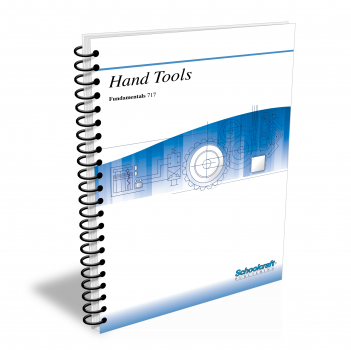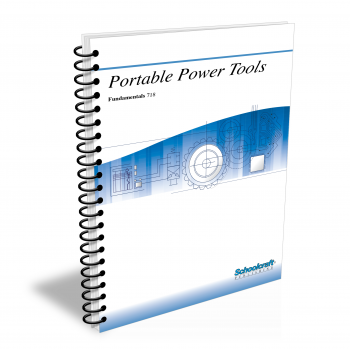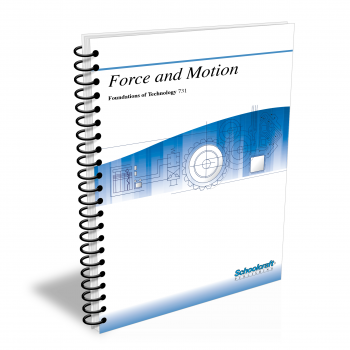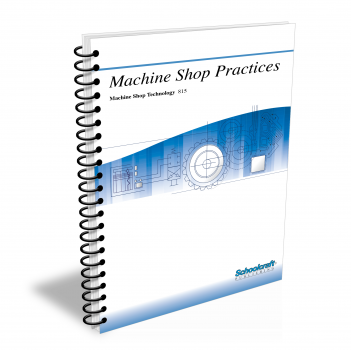Introduction to Hand and Power Tools
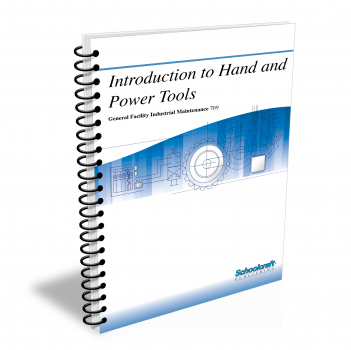
Course Number: 709
NEW TEXTBOOK - Now Available!
The Introduction to Hand and Power Tools textbook describes the most important hand and power tools used in industry. It begins with a chapter on common measurement tools used to monitor and adjust equipment. It continues with a discussion about units of measurement and the types of hand tools used for specific crafts such as pipefitting, plumbing, and electrical. The second half of this textbook explores basic power tools and their function, as well as the powered equivalent of some of the basic hand tools discussed in earlier chapters. The final chapters contain an overview of tool maintenance and a review of proper tool sharpening practices.
Does your curriculum require additional topics not included in this textbook? Build a customized version of the Introduction to Hand and Power Tools textbook below.
Customize this book by adding additonal chapters:Recommended Contact Hours – 30
Preview a Chapter
Available Supporting Material
- Table of Contents
- Exam Copies
- Suggested Titles
Table of Contents
Chapter 1: Measurement Tools and Instruments
Topics: Classification of instruments; Measurements in maintenance; Process monitoring and quality assurance; Predictive maintenance
Learning Objectives:
- Define measurement, parameter, accuracy, precision, sensitivity, and range.
- Explain why measurements are important to maintenance operations.
- Describe the general features of a portable measurement instrument.
- List the basic measurement instruments most often used in mechanical maintenance, and describe the operating principles of each.
Chapter 2: Measuring Tools
Topics: Linear and angular measurement; Rules and measuring tapes; Slide, vernier, and micrometer caliper; Squares
Learning Objectives:
- Explain how to hold a rigid rule correctly when measuring an object and show from which point the measurement begins.
- Describe how to set lock joint transfer-type calipers.
- Identify vernier calipers.
- Explain how to take a measurement with a micrometer caliper.
- Name the parts of a combination square.
Chapter 3: The Safe Use of Hand Tools
Topics: Screwdrivers; Wrenches; Hammers and mallets; Chisels; Punches; Saws; Files and rasps; Snips, nippers, and cutters; Pliers; Organizing tools
Learning Objectives:
- Name the major hand tools used in maintenance.
- State criteria for selecting the proper tools for specific jobs.
- Identify safe/unsafe practices in the use of hand tools and explain why they are safe/unsafe.
- Explain how to prolong the useful life of selected hand tools.
- Explain the advantages of having a well-organized tool box.
Chapter 4: Wrenches and Screwdrivers
Topics: Wrenches-open-end, box-end, combination, socket, adjustable, torque; Screwdrivers-standard, cross-slot, spiral, ratchet, offset; Driving and removing screws; Restoring a blade
Learning Objectives:
- Identify types of materials used for making wrenches.
- Identify open-end, box-end, socket, socket-head, adjustable, torque, and striking-face wrenches.
- Describe two sizes that are important in identifying a socket wrench.
- Identify standard, Phillips, offset, and spiral-ratchet screwdrivers.
- List the steps to follow when driving a screw.
Chapter 5: Fasteners
Topics: Threaded fasteners; Screw threads; Types of nuts; Washers; Safety wiring; Keys and pins; Rivets
Learning Objectives:
- Identify seven major types of threaded fasteners.
- Read and interpret common screw thread and threaded fastener specifications.
- Describe the three actions in a manual riveting operation, and explain why each action must be done properly.
- Demonstrate the proper technique for safety wiring a group of threaded fasteners.
- Identify three kinds of washers.
Chapter 6: Pipefitting Tools
Topics: Pipe wrenches; Vises; Cutting, reaming, threading, and tapping pipe; Cutting tubing and plastic pipe; Flaring tubing; Tool care
Learning Objectives:
- Identify a straight pipe wrench, a Stillson wrench, a chain pipe wrench, a strap wrench, and a compound-leverage wrench.
- Explain how to use a pipe wrench.
- Explain why a machinists' vise should not be used for holding pipe.
- Explain how to thread pipe.
- Explain how to clean a pipe tool.
- Explain how to cut and flare tubing.
Chapter 7: Plumbing Tools
Topics: Plumbing systems and codes; Joining pipe; Tube bending; Cutting and assembling pipe; Plungers; Augers; Sewer tapes; Special wrenches
Learning Objectives:
- Explain how to use a mechanical tube bender.
- List the steps in joining hubless pipe.
- Explain why the drain pipe should be completely covered by the force cup.
- Name the criteria used in selecting line clearing tools.
- List the steps in measuring pipe when using the center-to-center measuring systems.
Chapter 8: Electrician's Tools
Topics: EMT bender; Bending and assembling conduit; Knockout punches; Fish tapes; Pliers; Wire and cable strippers; Test and safety equipment
Learning Objectives:
- Explain how to use an EMT bender and a neon circuit tester.
- List the parts of a knockout punch.
- Name the uses of the all-purpose tool.
Chapter 9: Metalworking Tools
Topics: Vises; Hacksaws; Files; Taps; Dies; Thread classes; Reamers
Learning Objectives:
- Select the proper hacksaw blades for cutting various materials.
- Explain the difference between single-cut and double-cut files.
- List the types of taps usually found in a tap set.
- Explain how to cut an external thread on a bolt, screw, or stud.
- Explain how to remove a reamer from a hole.
Chapter 10: The Safe Use of Portable Power Tools
Topics: Hazards; Protection against shock; Drills, sanders, grinders, saws, shears, impact wrenches, and rotary hammers; Pneumatic tools
Learning Objectives:
- State three precautions to take before using any power tool.
- Describe the safe use of each of the following power tools: electric drills, sanders, grinders, and saws; electric impact tools; pneumatic impact wrenches and hammers.
- State three general guidelines for the safe operation of any portable power tool.
- Describe the potential electrical hazards associated with electric power tools.
Chapter 11: Electric Drills
Topics: Construction; Light- and heavy-duty drills; Accessories; Drill sizes and bits; Use and maintenance; Safety
Learning Objectives:
- Name four parts that are common to both the light-duty drill and the heavy-duty drill.
- Name the parts of a drill bit.
- Explain how to drill a blind hole.
- Explain how to inspect a drill bit, both visually and through testing.
- List the safety rules to follow when using electric power tools.
Chapter 12: Electric Hammers
Topics: Operation; Bits and chisels; Self-drilling anchors; Mechanical, electrical, and environmental safety
Learning Objectives:
- Explain the difference in hammering action between a percussion hammer and a rotary hammer.
- Select the proper chisel to use for each of the following jobs: brick cleaning; general demolition work; edging, chipping, and channeling; and removing floor tile.
- List the precautions that should be taken to ensure electrical safety when using an electric hammer.
- Name two safety items to use when operating an electric hammer in damp or wet areas.
Chapter 13: Pneumatic Drills and Hammers
Topics: Drill types and sizes; Bits; Operation; Hammer types; Chipping and scaling; Star drilling; Riveting; Tampers; Needle scalers; Diggers; Maintenance
Learning Objectives:
- Explain how drill size is determined.
- Describe the chiseling action of a bull point chisel when it is used to clean masonry seams.
- Describe how to use a rivet buster.
- Explain drill speed requirements.
- Identify various types of drill bits used in pneumatic hammers.
Chapter 14: Linear-Motion Saws
Topics: Straight-blade power saws; Saber saws; Plunge and straight cutting; Cutting metal; Reciprocating saws and blades; Band saws
Learning Objectives:
- List other names for both the saber saw and the reciprocating saw.
- Describe the cutting action of a saber saw.
- Explain how to draw a saw blade with regular set teeth and one with wavy set teeth.
- Explain how to plunge cut a rectangular opening.
- List the types of band saw blades described in this Lesson and a few characteristics of each.
Chapter 15: Circular Saws
Topics: Blades; Crosscutting; Ripping; Angular cutting; Plunge cutting; Notching and grooving; Cut-off wheels; Arbors; Accessories; Safety
Learning Objectives:
- Name the major parts of a circular saw.
- Describe the cutting action of a circular saw.
- List the factors that determine feed speed.
- State the definition of an arbor.
- Identify different types of blades.
Chapter 16: Electric Sanders
Topics: Belt, pad, orbital, and oscillating sanders; Use and maintenance; Disk sanders; Safety
Learning Objectives:
- Explain how to install a sanding belt.
- Identify different types of sanding belts.
- Explain how to flush the gear chamber of a belt sander.
- Discuss the assembly of a sanding disk.
- List the safety rules to follow when using a disk sander.
Chapter 17: Grinders and Shears
Topics: Grinder selection; Wheel classification; Mounting grinding wheels; Maintenance; Safety; Shears and nibblers selection and use
Learning Objectives:
- State the meaning of each symbol in the six-symbol standard marking system for grinding wheels.
- Explain the correct procedure for mounting a grinding wheel.
- List safety rules to follow when using a grinder.
- Discuss how to maintain grinders.
Chapter 18: Tool Sharpening
Topics: Whetstones; Using a bench grinder; Sharpening chisels, drill bits, screwdrivers, pointed tools, reamers, taps, and dies; Other methods
Learning Objectives:
- State the reasons for sharpening tools.
- Explain the use of whetstones
- Identify a bench stone.
- Explain how to sharpen taps, dies, screwdrivers, and chisels
Chapter 19: How to Grind Single-Point Tools
Topics: Tool materials; Relief angles; Grinders and grinding wheels; Finishing, grooving, and threading tools; Carbide-tipped tools
Learning Objectives:
- Describe the various materials used for tools.
- Identify the parts of a single--point tool.
- List important specifications for single-point cutting tools.
- Name the two basic types of grinders and explain how they are used to sharpen single-point tools.
- Explain the standard marking system for grinding wheels.
- Describe the best way to grind carbide-tipped tools.
Request Exam Copies
Exam Copies
Ready to see a copy of our textbooks? After selecting which textbooks you’d like to review for your course, you can submit your request by either logging in or creating an account so we know where to ship your exam copies. A representative from Schoolcraft will contact you to confirm and finish processing your request.
Exam copies are always free and yours to keep.
Selected Exam Copies
none selected
* Maximum of five copies can be ordered
